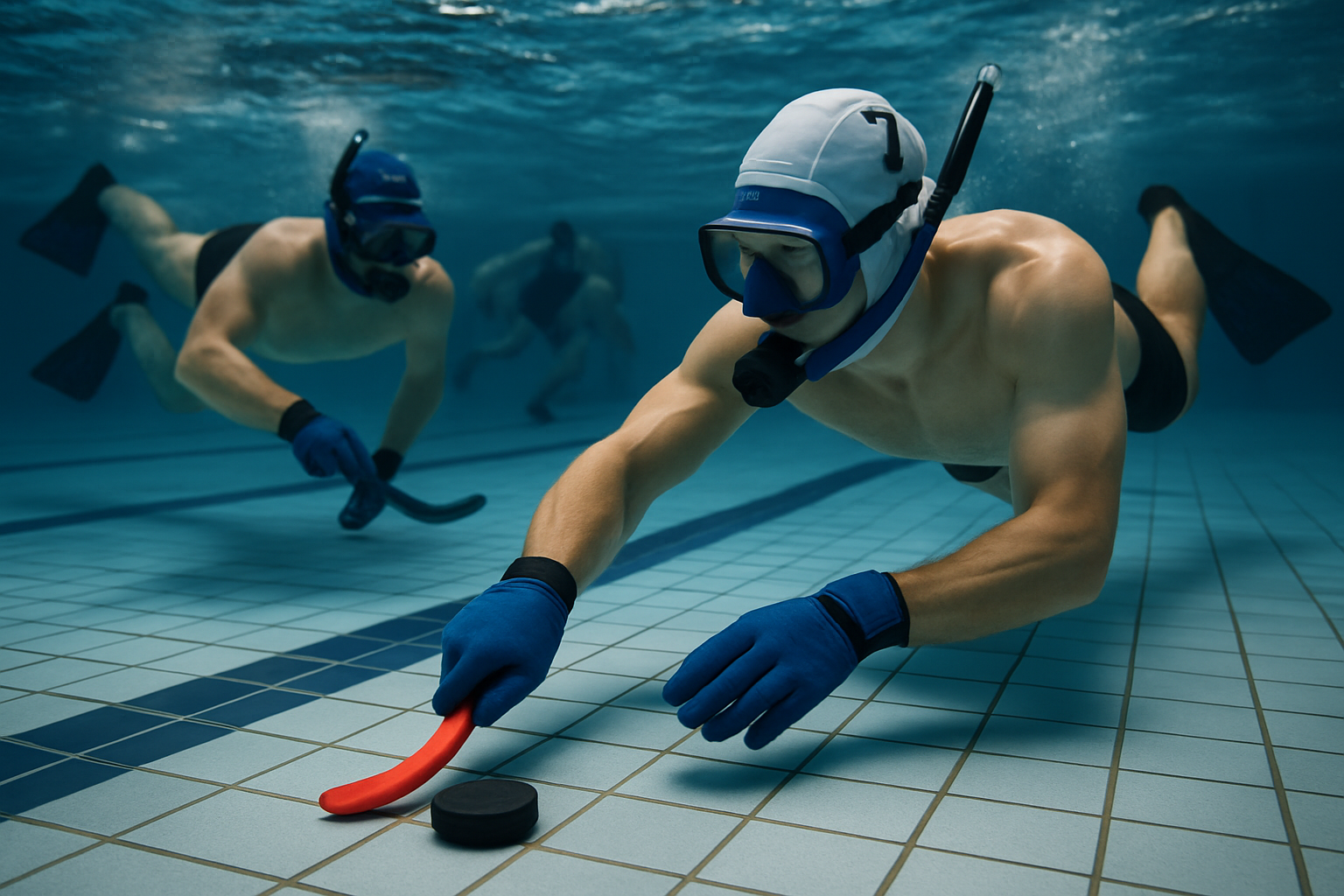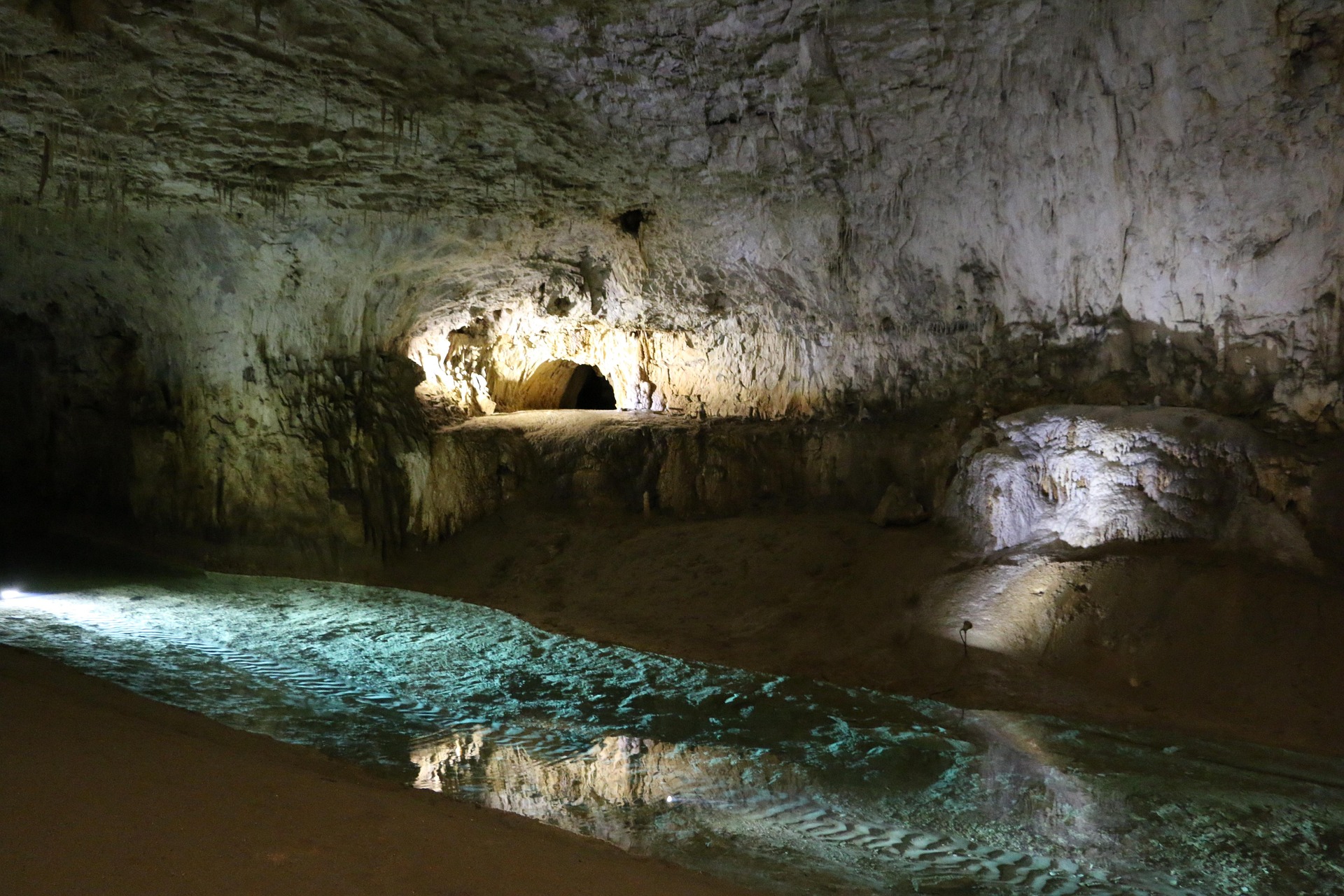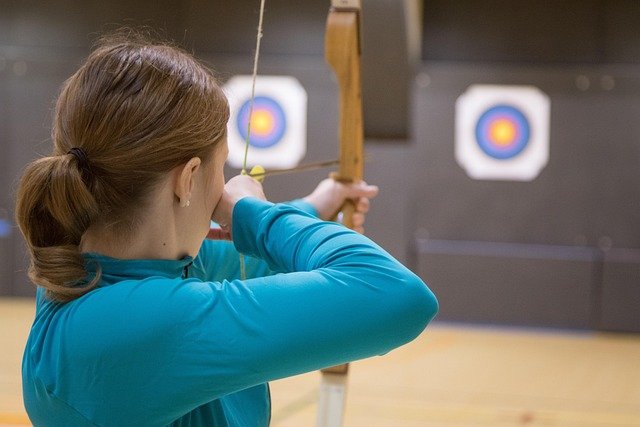Underwater Hockey: The Submerged Sport Taking the World by Storm
A pool erupts with activity as players wielding curved sticks glide through the water, chasing a puck along the bottom. This isn't your typical hockey game – it's happening entirely underwater. Welcome to the thrilling world of underwater hockey, a unique sport combining elements of traditional ice hockey, water polo, and free diving. As athletes push their aquatic limits, this emerging discipline is making waves in the global sporting community.

Early matches were chaotic affairs, with players struggling to navigate the underwater environment while competing for possession. However, as techniques improved and equipment became more specialized, underwater hockey began to take shape as a legitimate sport. The first official competition took place in 1955, marking the beginning of a new era in aquatic athletics.
Throughout the 1960s and 1970s, underwater hockey spread beyond British shores, finding enthusiasts in Australia, Canada, and South Africa. The sport’s growth led to the formation of the World Underwater Federation (CMAS) in 1959, which continues to govern international competitions today.
Gameplay and Rules
At its core, underwater hockey is a test of aquatic skill, teamwork, and endurance. Two teams of six players each compete to maneuver a puck into the opposing team’s goal at the bottom of a swimming pool. The playing area is typically 25 meters long and 15 meters wide, with goals measuring 3 meters in width at each end.
Players are equipped with fins, masks, snorkels, and protective gear, including gloves and headgear. The most crucial piece of equipment is the stick, a short, curved implement about 30 centimeters long, used to control and strike the puck. The puck itself is made of lead, coated in plastic, and weighs approximately 1.5 kilograms, allowing it to remain at the bottom of the pool.
Matches consist of two 15-minute halves, with a brief halftime break. Players must surface regularly to breathe, making strategic play and efficient movement crucial. Substitutions are allowed at any time, enabling teams to maintain a high level of intensity throughout the match.
Fouls in underwater hockey include obstruction, stick infractions, and dangerous play. Penalties can result in players being sent to a penalty box, giving the opposing team a numerical advantage. The fast-paced nature of the game and the need for constant movement make it a physically demanding sport that requires excellent cardiovascular fitness and breath-holding capabilities.
Training and Physical Demands
Underwater hockey players face unique challenges that set the sport apart from its surface-based counterparts. The ability to hold one’s breath for extended periods while engaging in intense physical activity is paramount. As such, training regimens for underwater hockey athletes are multifaceted and rigorous.
Breath-holding exercises form a crucial part of any underwater hockey training program. Players practice static apnea (holding breath while remaining still) and dynamic apnea (holding breath while swimming) to increase their lung capacity and CO2 tolerance. These exercises not only improve performance during matches but also enhance overall safety in the water.
Cardiovascular conditioning is another critical aspect of training. High-intensity interval training (HIIT) and endurance swimming help players build the stamina necessary to maintain peak performance throughout a match. Many athletes incorporate cross-training activities such as running, cycling, and strength training to develop overall fitness and explosive power.
Pool-based drills focus on improving puck handling skills, underwater agility, and team coordination. Players practice maneuvering the puck while submerged, executing quick turns, and communicating with teammates using hand signals and body language. Scrimmages allow teams to refine their strategies and develop cohesion in a competitive setting.
Mental preparation is equally important in underwater hockey. Players must remain calm and focused while operating in an environment that can be disorienting and potentially stressful. Visualization techniques and mindfulness practices are often employed to help athletes maintain composure during matches.
Global Growth and Competition
In recent years, underwater hockey has experienced a surge in popularity, with national federations established in over 30 countries across six continents. The sport’s global reach has led to the development of international competitions, fostering a sense of community among players worldwide.
The CMAS Underwater Hockey World Championship, held biennially, is the premier event in the sport’s calendar. Teams from around the globe compete for gold in both men’s and women’s divisions, showcasing the highest level of skill and strategy. Recent championships have seen dominance from traditional powerhouses like New Zealand, Australia, and France, but emerging nations such as Colombia and Turkey are making significant strides in international competition.
Regional tournaments, such as the European Championship and the Pan-American Championship, provide additional opportunities for national teams to compete and raise the profile of underwater hockey. These events serve as important stepping stones for developing nations and help to identify rising talent in the sport.
At the grassroots level, club competitions and local leagues are flourishing in many countries. Universities and colleges are increasingly recognizing underwater hockey as a competitive sport, leading to the formation of collegiate leagues and fostering talent development among younger players.
Technological Advancements in Equipment
As underwater hockey has evolved, so too has the equipment used by players. Technological advancements have led to the development of specialized gear that enhances performance and safety in the water.
Modern underwater hockey sticks are marvels of engineering, designed to maximize puck control and shot power while minimizing water resistance. Manufacturers employ computer-aided design and advanced materials such as carbon fiber and reinforced plastics to create sticks that are both durable and hydrodynamic.
Fins have also seen significant improvements, with designs optimized for the quick bursts of speed and rapid changes in direction required in underwater hockey. Some players opt for shorter, stiffer fins that allow for greater maneuverability, while others prefer longer fins for enhanced propulsion.
Masks and snorkels have been refined to provide better visibility and ease of breathing. Low-profile masks with wide fields of vision are favored, often featuring anti-fog coatings to ensure clear sight lines throughout the match. Snorkels are designed to minimize drag and allow for quick clearing of water.
Protective gear has become more sophisticated, with gloves featuring reinforced knuckle protection and improved grip. Headgear designs now incorporate impact-resistant materials to protect players from collisions and errant pucks, while still allowing for clear hearing underwater.
Advancements in underwater camera technology have also benefited the sport, enabling better analysis of gameplay and providing spectators with immersive viewing experiences. Some tournaments now feature underwater cameras that transmit live footage to screens above the pool, allowing audiences to follow the action in real-time.
Challenges and Future Prospects
Despite its growing popularity, underwater hockey faces several challenges as it seeks wider recognition and participation. One of the primary obstacles is the lack of visibility for spectators, which can make it difficult to attract large audiences and media coverage. Innovations in underwater filming and live streaming technology are helping to address this issue, but more work remains to be done to make the sport truly spectator-friendly.
Another challenge is the limited availability of suitable facilities. Underwater hockey requires specific pool configurations and equipment, which can be costly for clubs and organizations to maintain. Efforts are underway to develop portable, modular pool systems that could make the sport more accessible to a wider range of communities.
The physical demands of underwater hockey can also be a barrier to entry for some potential players. Overcoming the initial discomfort of prolonged breath-holding and underwater exertion requires patience and dedication. However, proponents of the sport argue that these challenges are also part of its appeal, offering a unique and rewarding athletic experience.
Looking to the future, underwater hockey enthusiasts are working tirelessly to raise the sport’s profile and secure its place in major multi-sport events. While inclusion in the Olympic Games remains a long-term goal, there is growing momentum for underwater hockey to be featured in regional competitions such as the Pan American Games and the Commonwealth Games.
Efforts are also underway to expand the sport’s reach in developing countries, with initiatives focused on introducing underwater hockey to new audiences and providing coaching and equipment support. The potential for growth in regions with strong swimming cultures, such as Southeast Asia and the Caribbean, is particularly promising.
The Environmental Connection
Underwater hockey’s unique setting has led to an increased awareness of aquatic ecosystems among its participants. Many players develop a deep appreciation for the underwater world, which often translates into a commitment to ocean conservation and water quality issues.
Some underwater hockey clubs have partnered with environmental organizations to conduct clean-up dives in local water bodies, removing trash and debris from underwater environments. These initiatives not only help to preserve aquatic habitats but also raise public awareness about the importance of protecting our water resources.
The sport’s reliance on clean, clear water has made the underwater hockey community a vocal advocate for improved water quality standards and the preservation of natural swimming areas. Players often become citizen scientists, monitoring water conditions and reporting potential environmental hazards to local authorities.
Educational programs have emerged that use underwater hockey as a tool to teach young people about marine biology, water safety, and environmental stewardship. These programs combine practical skills development with ecological awareness, fostering a new generation of environmentally conscious athletes.
Inclusivity and Diversity in Underwater Hockey
One of the strengths of underwater hockey is its inclusivity. The sport’s unique nature tends to level the playing field, allowing people of various body types and backgrounds to compete on equal terms. The underwater environment negates many of the physical advantages that dominate other sports, placing a premium on technique, stamina, and teamwork.
Women’s participation in underwater hockey has grown significantly in recent years, with many countries fielding strong female teams in international competitions. The sport’s governing bodies have made concerted efforts to promote gender equality, ensuring equal representation in tournaments and leadership positions.
Age diversity is another hallmark of underwater hockey. It’s not uncommon to see players ranging from teenagers to septuagenarians competing together in club matches. The low-impact nature of the sport, combined with its cardiovascular benefits, makes it an attractive option for older athletes looking to maintain their fitness and competitive edge.
Efforts are also being made to make underwater hockey more accessible to people with disabilities. Modified versions of the sport have been developed for individuals with visual impairments, and research is ongoing to create adaptive equipment that would allow participation for those with mobility challenges.
The Psychology of Underwater Hockey
The mental aspects of underwater hockey are as crucial as the physical demands. Players must develop a unique psychological skill set to excel in this submerged sport. The ability to remain calm and focused while holding one’s breath and engaging in intense physical activity is paramount.
Sports psychologists working with underwater hockey athletes focus on techniques to manage anxiety and maintain concentration in the challenging aquatic environment. Visualization exercises are commonly employed, helping players to mentally rehearse their movements and strategies before entering the pool.
The sport also requires a high degree of trust and non-verbal communication among teammates. Players must rely on intuition and pre-established signals to coordinate their actions, as verbal communication is impossible underwater. This fosters a strong sense of camaraderie and teamwork that often extends beyond the confines of the pool.
Underwater hockey’s unique nature can also have therapeutic benefits. Some mental health professionals have begun incorporating the sport into treatment programs for anxiety and PTSD, citing its meditative qualities and the sense of weightlessness experienced underwater as potentially beneficial for patients.
Nutrition and Recovery in Underwater Hockey
The nutritional needs of underwater hockey players are distinct from those of many other athletes. The sport’s combination of breath-holding, intense bursts of activity, and prolonged submersion creates unique demands on the body that must be addressed through careful dietary planning.
Proper hydration is crucial, as players can easily become dehydrated during matches despite being surrounded by water. Electrolyte balance is also a key concern, with many athletes opting for specially formulated sports drinks to replenish lost minerals.
Diets rich in complex carbohydrates and lean proteins are typically recommended to provide sustained energy for training and competition. Some players experiment with low-acid diets, believing they can help improve breath-holding capacity by reducing the body’s CO2 production.
Recovery strategies for underwater hockey players often include contrast water therapy, alternating between hot and cold water immersion to reduce muscle soreness and inflammation. Yoga and stretching routines tailored to the specific muscle groups used in the sport are also popular among players looking to maintain flexibility and prevent injuries.
The Role of Technology in Training and Performance Analysis
As underwater hockey continues to evolve, technology is playing an increasingly important role in training and performance analysis. Wearable devices designed to function in aquatic environments are being used to track players’ movements, heart rates, and oxygen saturation levels during training and matches.
Video analysis software, adapted for underwater use, allows coaches to break down gameplay and provide detailed feedback to players. Some teams are experimenting with virtual reality systems to simulate match scenarios and improve decision-making skills without the need for pool time.
3D printing technology is being utilized to create customized equipment, such as mouthguards and stick handles, tailored to individual players’ preferences and anatomical features. This level of customization can provide a competitive edge and enhance comfort during play.
Artificial intelligence and machine learning algorithms are being developed to analyze vast amounts of match data, helping teams to identify patterns and optimize their strategies. These tools have the potential to revolutionize tactical approaches to the game and elevate the level of play across the sport.
Conclusion
Underwater hockey stands as a testament to human ingenuity and the endless pursuit of athletic challenge. From its humble beginnings as a training exercise for divers, it has evolved into a globally recognized sport that pushes the boundaries of aquatic athleticism. As it continues to grow and develop, underwater hockey offers a unique blend of physical prowess, mental fortitude, and environmental awareness.
The sport’s future looks bright, with increasing participation rates, technological advancements, and a growing appreciation for its unique attributes. As more people discover the thrill of competing beneath the surface, underwater hockey is poised to make an even bigger splash in the world of international sports.
Whether as a competitive pursuit or a recreational activity, underwater hockey provides a gateway to a fascinating submerged world. It challenges participants to embrace the unknown, overcome physical limitations, and work in harmony with their teammates in an environment that is both alien and exhilarating. As the sport continues to evolve, it will undoubtedly inspire new generations of athletes to take the plunge and experience the excitement of this dynamic underwater discipline.





